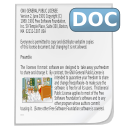NLP text classification in tweets related to natural disasters
Abstract
Currently there is a large amount of information circulating through social networks, this does not always tend to be true and in the case of natural disasters its falsity could have quite consequences such as mass hysteria in the population. To avoid this, an efficient analysis was proposed to check tweets with false information using natural language processing algorithms.
Downloads
References
S. K. Theja Bhavaraju, C. Beyney y C. Nicholson, "Quantitative analysis of social media sensitivity to natural disasters", International Journal of Disaster Risk Reduction, vol. 39, p. 101251, octubre de 2019. [En línea]. Disponible: https://doi.org/10.1016/j.ijdrr.2019.101251 DOI: https://doi.org/10.1016/j.ijdrr.2019.101251
S. Hansson et al., "Communication-related vulnerability to disasters: A heuristic framework", International Journal of Disaster Risk Reduction, vol. 51, p. 101931, diciembre de 2020. [En línea]. Disponible: https://doi.org/10.1016/j.ijdrr.2020.101931 DOI: https://doi.org/10.1016/j.ijdrr.2020.101931
F. K. Sufi, "AI-SocialDisaster: An AI-based software for identifying and analyzing natural disasters from social media", Software Impacts, p. 100319, mayo de 2022. [En línea]. Disponible: https://doi.org/10.1016/j.simpa.2022.100319 DOI: https://doi.org/10.1016/j.simpa.2022.100319
S. Deb y A. K. Chanda, "Comparative analysis of contextual and context-free embeddings in disaster prediction from Twitter data", Machine Learning With Applications, vol. 7, p. 100253, marzo de 2022. [En línea]. Disponible: https://doi.org/10.1016/j.mlwa.2022.100253 DOI: https://doi.org/10.1016/j.mlwa.2022.100253
Y. Lian, Y. Liu y X. Dong, "Strategies for controlling false online information during natural disasters: The case of Typhoon Mangkhut in China", Technology in Society, vol. 62, p. 101265, agosto de 2020. [En línea]. Disponible: https://doi.org/10.1016/j.techsoc.2020.101265 DOI: https://doi.org/10.1016/j.techsoc.2020.101265
Raina, V., Krishnamurthy, S., “Natural Language Processing”. In: Building an Effective Data Science Practice.Apress, Berkeley, CA, diciembre de 2021 Disponible. https://doi.org/10.1007/978-1-4842-7419-4_6 DOI: https://doi.org/10.1007/978-1-4842-7419-4_6
K. R. Chowdhary, Fundamentals of Artificial Intelligence. New Delhi: Springer India, 2020.[En línea]. Disponible: https://doi.org/10.1007/978-81-322-3972-7 DOI: https://doi.org/10.1007/978-81-322-3972-7
J. K. Tripathy et al., "Comprehensive analysis of embeddings and pre-training in NLP", Computer Science Review, vol. 42, p. 100433, noviembre de 2021. [En línea]. Disponible: https://doi.org/10.1016/j.cosrev.2021.100433 DOI: https://doi.org/10.1016/j.cosrev.2021.100433
Kelleher, J. D. (2019). Deep Learning. MIT Press. DOI: https://doi.org/10.7551/mitpress/11171.001.0001
Yadav, A. y Vishwakarma, D. K. (2019). Sentiment analysis using deep learning architectures: a review. Artificial Intelligence Review, 53(6), 4335–4385. https://doi.org/10.1007/s10462-019-09794-5 DOI: https://doi.org/10.1007/s10462-019-09794-5
Copyright (c) 2023 Innovación y Software

This work is licensed under a Creative Commons Attribution 4.0 International License.
The authors exclusively grant the right to publish their article to the Innovation and Software Journal, which may formally edit or modify the approved text to comply with their own editorial standards and with universal grammatical standards, prior to publication; Likewise, our journal may translate the approved manuscripts into as many languages as it deems necessary and disseminates them in several countries, always giving public recognition to the author or authors of the research.
























